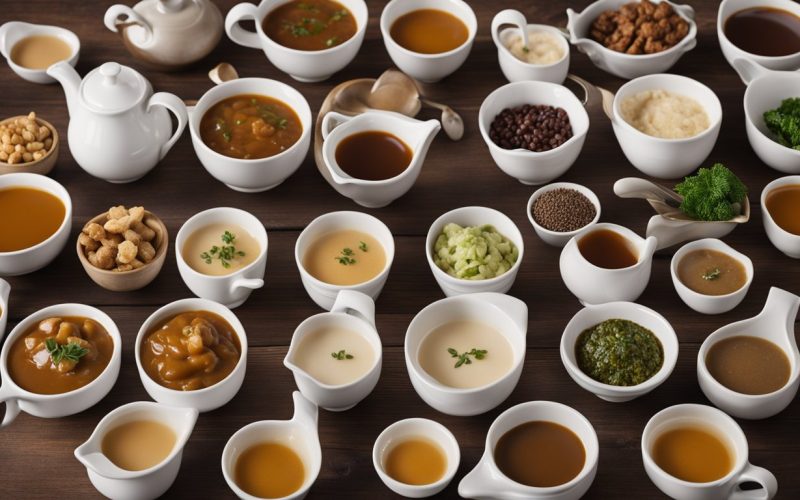Gravy is a fundamental element of comfort food that finds its way into many types of cuisine across America.
You pour it over mashed potatoes, slather it on biscuits, and use it to give meats and vegetables an extra layer of flavor.
Understanding different types of gravy can elevate your meals from good to unforgettable.
While the basic ingredients typically include some form of fat, a thickener like flour or cornstarch, and stock or milk, the variations and possibilities are endless.
When you start to explore the world of gravy, you discover a delicious spectrum of flavors that can complement almost any meal.
For instance, in the South, you might enjoy the rich, meaty taste of sawmill or sausage gravy, while a roux-based etouffee gravy brings a Cajun flair to your dish.
Aromatic herbs, spices, and additional ingredients such as meats, vegetables, or even chocolate add to the complex profiles of these gravies, creating signature recipes cherished in different regions.
Throughout America, gravy is more than just a sauce—it’s a tradition that enriches your dining experience.
Each recipe tells a story and connects you to regional tastes and family customs.
Whether you’re preparing a weeknight dinner or a festive holiday spread, knowing how different gravies can be prepared and paired will make your next meal a testament to this staple’s versatility and warmth.
How Many Types of Gravy Are There?
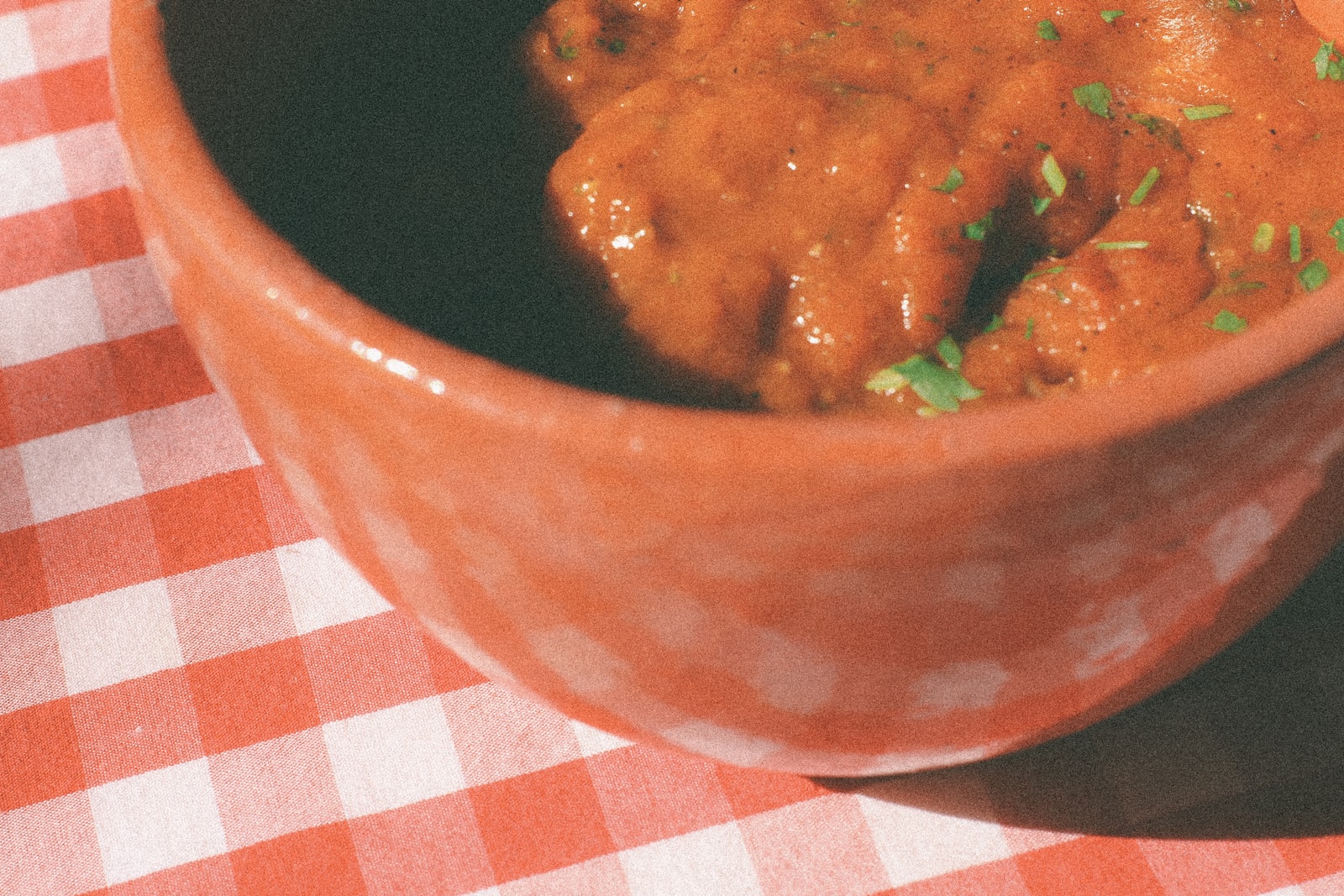
There are numerous types of gravy, each with variations depending on regional cuisines, ingredients, and preparation methods. Some common types include:
- Redeye Ham Gravy
- Cornmeal Gravy
- Chocolate Gravy
- Brown Gravy
- Sawmill Gravy
- Chili Gravy
- Red-eye Gravy
- S.O.S, aka Hamburger Gravy
- Chicken Gravy
- Tomato Gravy
- Sausage Gravy
- Turkey Gravy
- White Country Gravy
- Beef Broth Brown Gravy
- Mushroom Gravy
- Giblet Gravy
- Cream Gravy or White Gravy (Sawmill Gravy)
- Egg Gravy
These are just a few examples, and within each type, there might be further variations.
For instance, regional styles such as those found in the South, like Sawmill Gravy and Red-Eye Gravy, are distinct in their preparation and taste.
The list can be quite extensive when considering all the possible variations and regional specialties.
Different Types of Gravy
1. Red-eye Gravy

If you’re a fan of Southern cuisine, red-eye gravy is a classic you’ve got to try. Traditionally, you might enjoy it with biscuits and gravy for a hearty breakfast.
This savory sauce has a distinctive taste that comes from a unique blend of black coffee and the drippings from pan-fried country ham.
To make it, you start by frying a slice of country ham to perfection, which not only cooks the ham but also leaves behind flavorful drippings. Remove the ham once browned and set it aside.
The magic begins when you add brewed coffee directly into the skillet with the drippings.
The interaction between the coffee and the leftover ham fats creates a deep, rich flavor that’s a blend of salty-sweet notes.
Ingredients:
- Country ham
- Black coffee
Instructions:
- Cook the ham: Fry your country ham slice in a skillet until it’s browned.
- Make the gravy: Pour black coffee into the pan with the ham drippings.
- Simmer: Let the mixture reduce to intensify the flavor.
As you simmer, remember to season with a pinch of salt to balance the taste.
The absence of flour in this gravy makes it thinner but no less delicious.
The result is a buttery-smooth sauce with just a hint of bitterness from the coffee and a sweetness that complements the salty ham.
Serve your red-eye gravy over warm biscuits or alongside eggs for a breakfast that will transport you to the South.
It’s a bold choice if you’re looking to impress with your brunch game, and it’s sure to become a favorite for its unique flavor and simplicity.
2. White Gravy

White gravy, often hearty and rich, is a classic staple in Southern cuisine.
You’ll frequently find it smothered over biscuits or served alongside fried chicken.
At its core, white gravy is a simple roux—a mixture of fat and flour—to which milk is gradually added, creating what some call milk gravy or cream gravy.
Here’s how to make it:
- Start by heating your choice of fat – often lard or butter – in a skillet.
- Sprinkle in an equal amount of flour and stir to create the roux. Cook it until it’s just golden, being careful not to burn it.
- Slowly pour in warmed milk while whisking constantly to prevent lumps. Your aim is a creamy, thick sauce.
- Season with salt and plenty of cracked pepper for that characteristic bite.
Variations are aplenty. For a meaty kick, stir in cooked ground sausage, making what’s known as sausage gravy.
Whatever your choice, remember to cook your gravy until it reaches your desired consistency – it should nicely coat the back of a spoon.
Remember, the key to perfect white gravy is patience. Add the milk in small increments and keep the heat medium to avoid scorching.
The result? A comforting, creamy concoction ready to elevate your dish to the next level.
3. Chicken Gravy
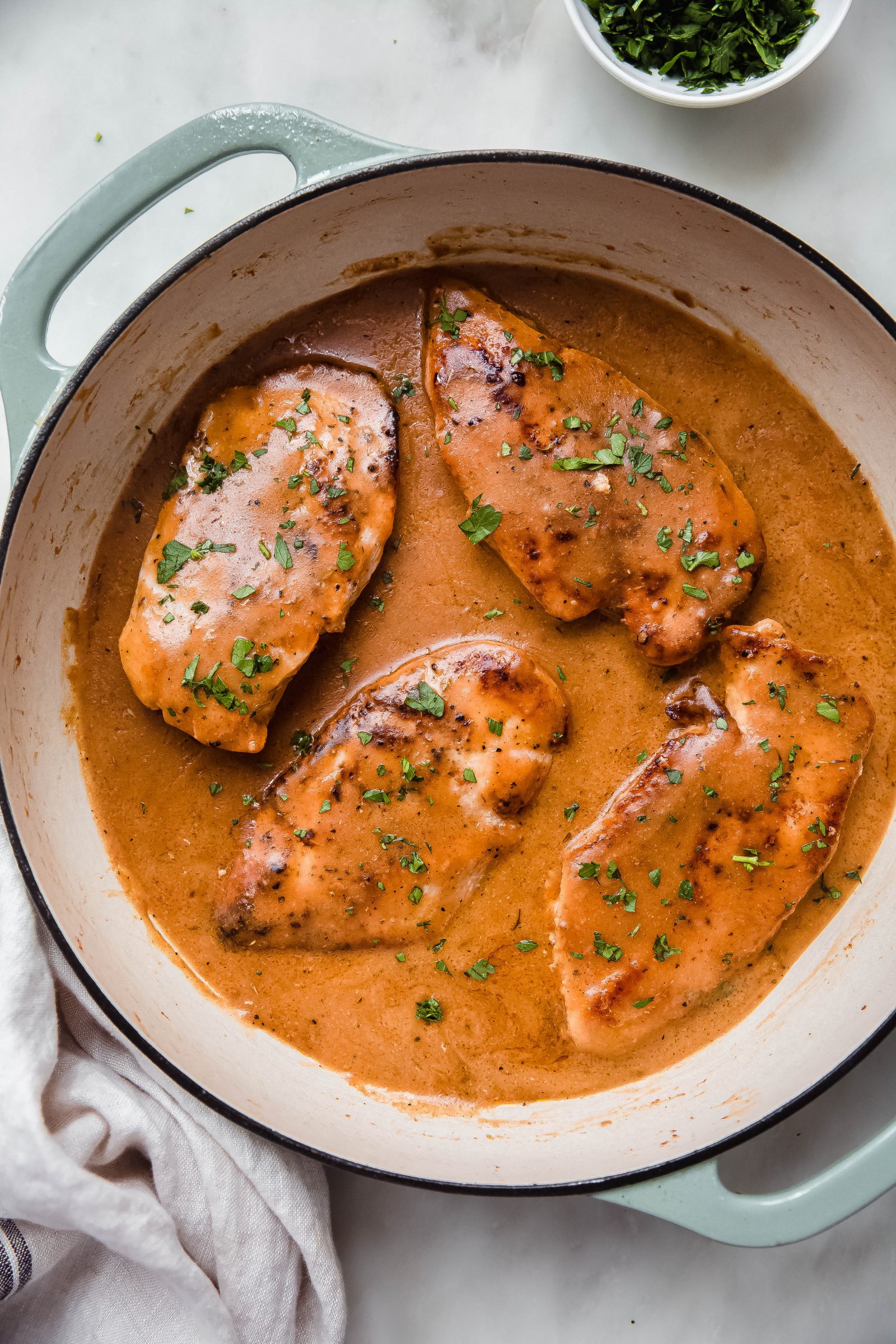
When preparing chicken gravy, you start by gathering the drippings from a roasted chicken.
These drippings are the foundation of your gravy, offering a deep flavor that you’ll enrich with broth and seasonings.
You might prefer using chicken broth, as it complements the drippings and enhances the poultry flavor.
For thickening your gravy, create a roux using equal parts of flour and the reserved fat from the drippings.
Cook the roux until it’s a light golden brown—it’s essential not to rush this step.
Once your roux is ready, gradually whisk in the chicken broth, ensuring it’s lump-free.
Simmer this mixture to your desired consistency, which should be velvety and creamy.
Now, it’s time to season your gravy. Salt and pepper are fundamental; start with a pinch of each and adjust to taste.
Chicken gravy is incredibly versatile. You can lavish it over a warm, buttery biscuit or alongside your favorite chicken dish.
With each spoonful, the smooth, rich flavors bring comfort and satisfaction to the palate. Here’s a simple breakdown to guide you:
- Collect chicken drippings and make a roux
- Thicken with flour and stir until golden brown
- Gradually add chicken broth, whisking constantly
- Simmer to a creamy consistency
- Season with salt and pepper to taste
- Serve over biscuits or with chicken dishes
Enjoy the process and savor every bit of your homemade chicken gravy!
4. Makhani Gravy
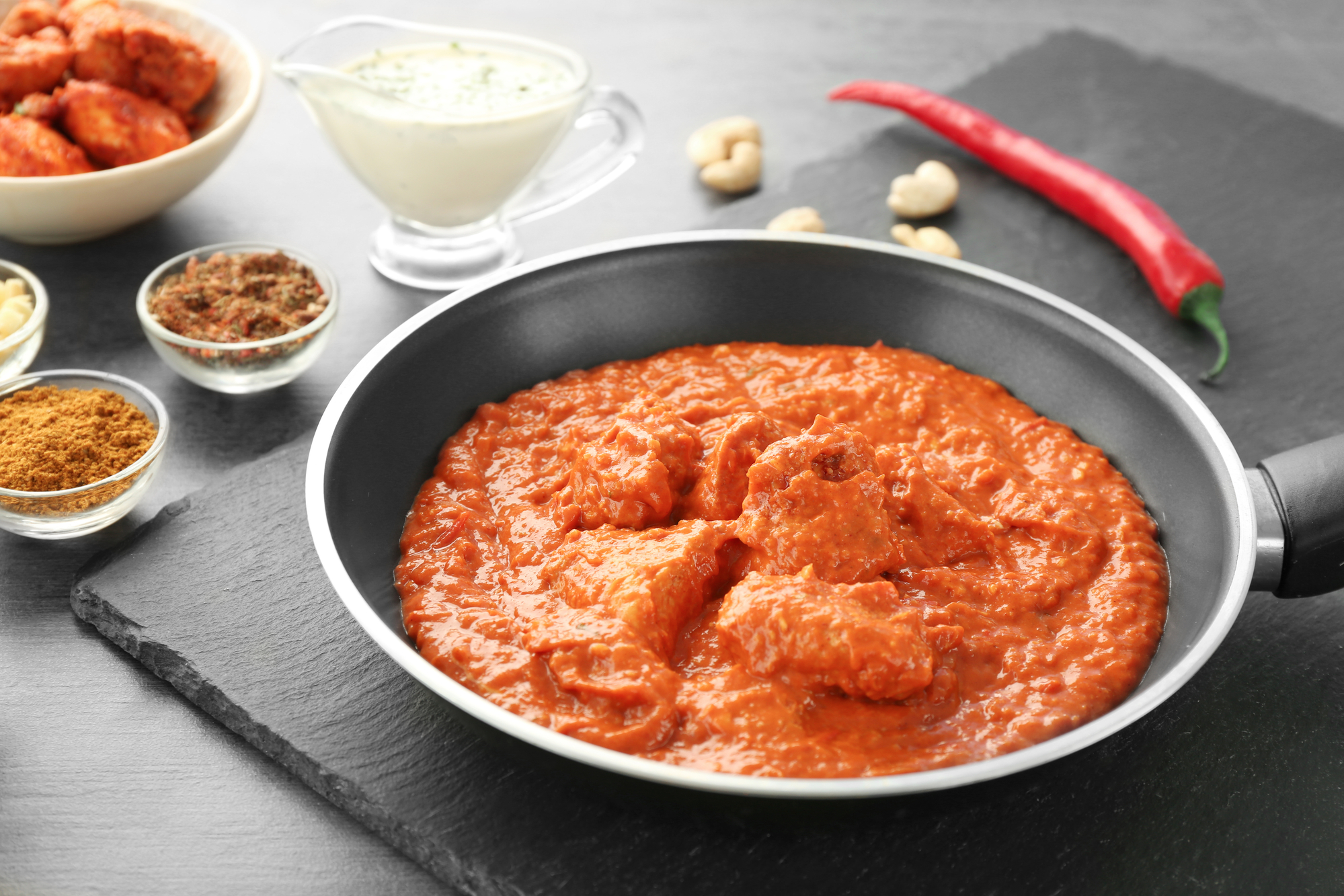
Makhani gravy stands out in Indian cuisine for its rich, creamy texture and delightful taste.
Typically, you’ll find this gravy enveloping pieces of tender chicken in dishes like Butter Chicken, but vegetarians also relish it with paneer as Paneer Makhani.
Ingredients:
- Tomatoes: The foundation provides a tangy base.
- Butter: Adds a velvety richness and is vital for an authentic flavor.
- Cream: Lends smoothness and mellows the tanginess of the tomatoes.
- Spices: A blend of garam masala, cardamom, and others infuse aroma and depth.
Preparation: Start by pureeing tomatoes to create a smooth base.
Heat butter in a pan and introduce your spices to unlock their fragrant oils.
Mix in the tomato puree and let it simmer. The colors deepen into a beautiful, rich hue as the gravy cooks.
Stir in cream to achieve a luxurious consistency.
Taste Profile:
- Rich: Courtesy of butter and cream.
- Spicy: From the carefully selected spices.
- Mildly Sweet: A subtle undertone balancing the tang.
When you prepare Makhani gravy, remember that quality ingredients make all the difference.
For an indulgent experience, don’t shy away from the butter or cream.
With each mouthful, you should taste the harmonious blend of spice and creaminess that makes Makhani gravy a beloved element of Indian cuisine.
5. Hariyali Gravy
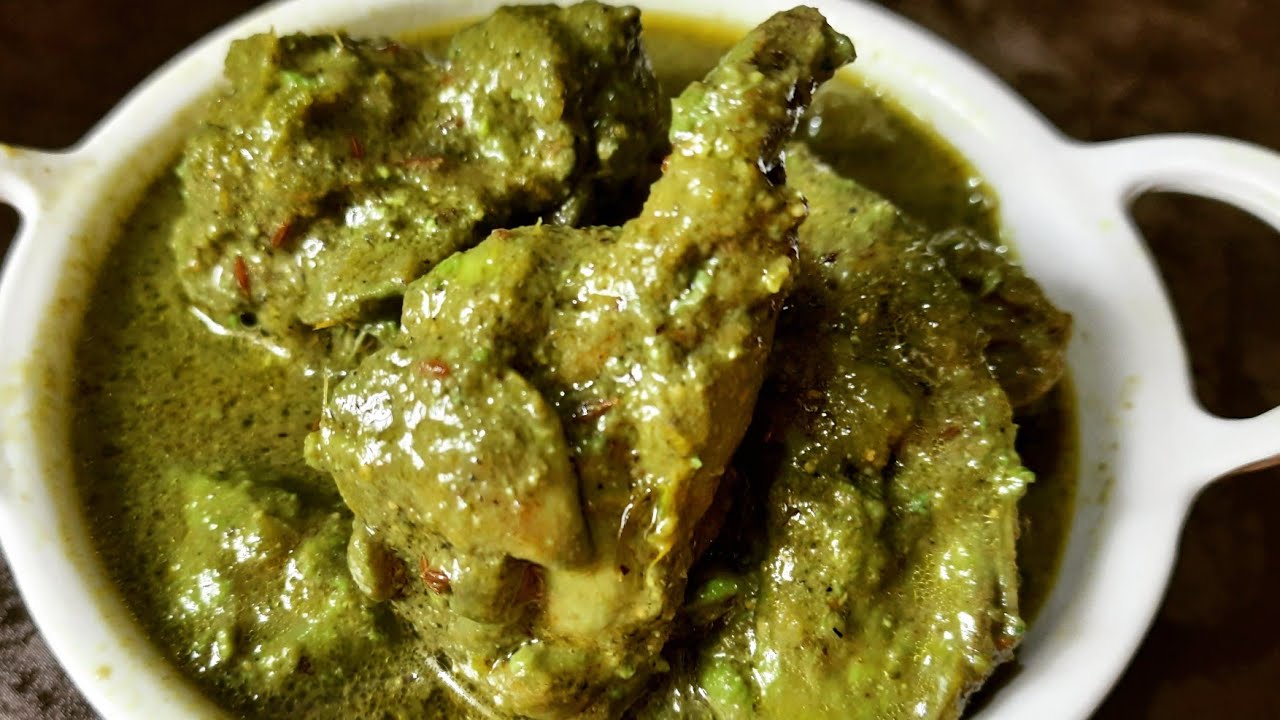
Hailing from the Indian subcontinent, Hariyali Gravy brings a vibrant and herbaceous flair to dishes.
The defining characteristic of this sauce consists of its rich green color, which comes from a blend of fresh herbs.
Ingredients:
- Herbs: Primarily, mint and coriander leaves are used to create the green base.
- Cream: Add cream to enrich the texture, although, for a vegan variant, you could use coconut milk or cashew paste.
- Spices: A mix of garam masala, cumin, and coriander powder balance the herby taste.
- Vegetables: Often included are spinach and green chilies to intensify the color and add a subtle heat.
Preparation Steps:
- Blend the herbs and green chilies into a smooth puree.
- Cook spices in oil until they release their aroma.
- Combine the herb puree with the spices and simmer.
- Finish with cream to add richness.
If you’re making Hariyali Chicken, marinate the chicken in some of the gravy before cooking.
The gravy pairs well with paneer and vegetables, too, making it versatile for various dishes.
To enjoy it at its freshest, consume Hariyali Gravy soon after preparation. Store any leftovers in the refrigerator promptly to maintain its flavors.
Enjoy experimenting with this green gravy to add a splash of color and a punch of flavor to your meals!
6. Palak Gravy
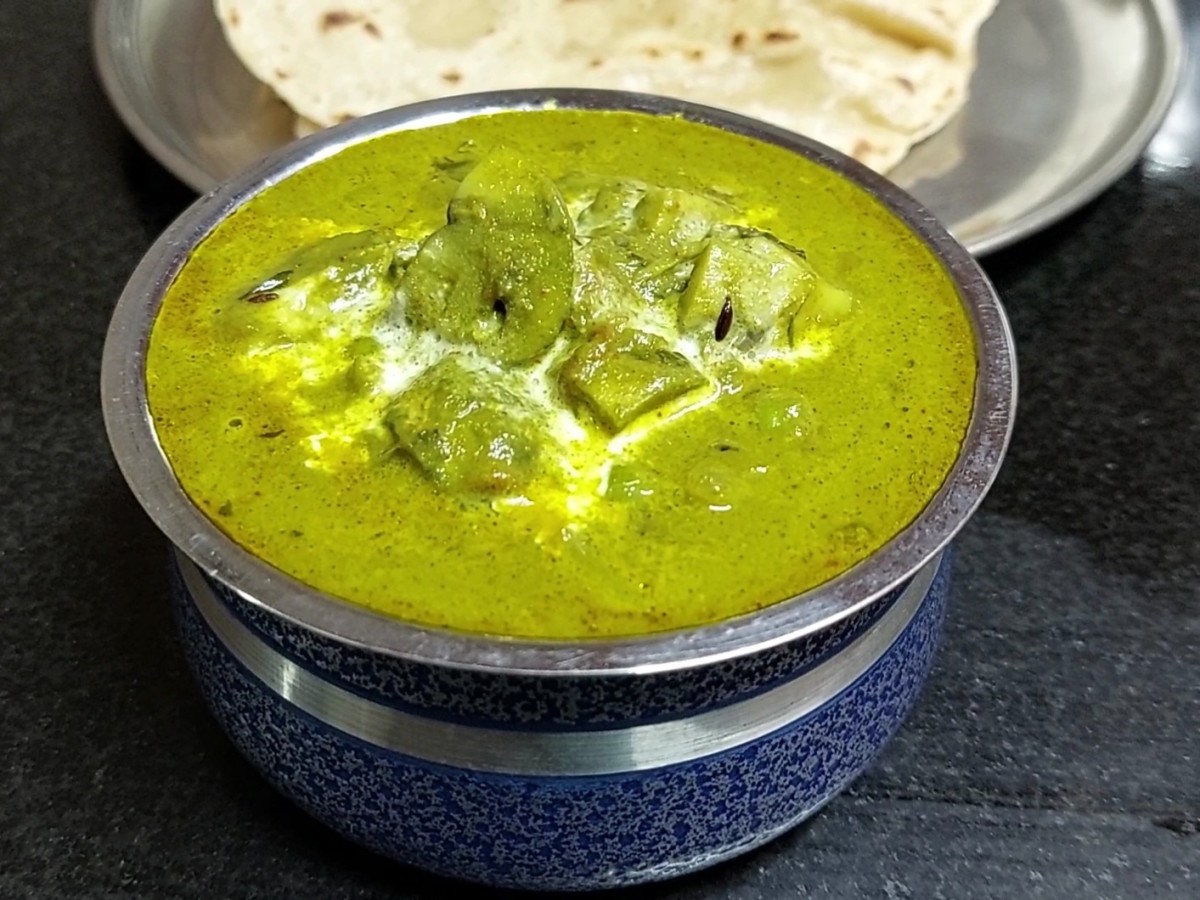
Palak gravy is a vibrant and flavorful base commonly used in Indian cuisine.
It integrates the nutritional benefits of spinach with a variety of spices to create a luscious sauce perfect for enriching your meals.
When making palak gravy, you first blanch the spinach to preserve its bright green color.
Boil water with a pinch of salt and a teaspoon of sugar before adding the spinach.
After a quick boil, plunge the spinach into ice-cold water to stop the cooking process.
To form the body of the gravy, blend the cooked spinach into a smooth paste.
You can enrich this base with various ingredients, such as cream for a velvety texture, which pairs excellently with proteins like chicken.
Here’s a simple breakdown of the method:
- Blanch the spinach in salted, sugared boiling water.
- Shock the spinach in ice water.
- Blend to a fine paste.
- Cook with cream, spices, and your choice of protein.
For seasoning, keep it simple. Salt is essential, but you might also want to add garlic and garam masala to enhance the complexity of flavors.
Pair your palak gravy with chicken for a wholesome dish, or enjoy it as a vegetarian option by incorporating paneer or tofu.
Whether you’re preparing a weeknight dinner or a special meal, this gravy will surely bring joy to your table.
7. Cornmeal Gravy

Cornmeal gravy is a hearty, comforting sauce that you can easily prepare and enjoy with various dishes.
Its simplicity and rich texture make it a staple in certain regional cuisines, particularly in the Southern United States.
Ingredients:
- Cornmeal
- Milk or buttermilk
- Bacon drippings
- Salt and pepper
Preparation Steps:
- Fry some bacon until crisp, and reserve the bacon drippings in a skillet.
- Gradually whisk in a generous amount of cornmeal to soak up the drippings and turn golden brown.
- Pour in milk or buttermilk steadily, stirring constantly to prevent lumps.
- Season with salt and pepper.
- Cook over medium heat until it reaches a thick consistency.
Traditionally, people serve cornmeal gravy over warm, flaky biscuits for a satisfying breakfast.
The savory flavor of the bacon complements the nuttiness of the cornmeal, creating a perfect balance that enhances your morning meal.
Not only does it go well with biscuits, but you can also pour it over meats or use it as a base for a more elaborate sauce.
Remember, the key is to keep stirring as the gravy thickens to achieve that smooth, velvety texture.
Also, feel free to adjust the thickness to your liking by either adding more cornmeal for thickness or more milk for a lighter gravy.
Enjoy your cornmeal gravy with a variety of breakfast items, or get creative and experiment with different pairings to discover your favorite combination.
8. Tomato Gravy

Have you ever tasted the rich and comforting flavors of tomato gravy?
This Southern delicacy combines the tanginess of tomatoes with a smooth, thick consistency, perfect for a variety of dishes.
You start by stewing down tomatoes with a mix of flavorful ingredients.
You’ll often find the base of tomato gravy begins with a roux made from flour and fat, such as from cooked bacon.
The flour helps thicken the gravy, creating a desirable texture that clings lovingly to biscuits, meats, or even a bowl of grits.
Here’s a basic process to make your own tomato gravy:
- Cook your roux: Mix flour with the warm bacon drippings in a pan. Stir constantly until you achieve a light brown color and a nutty aroma.
- Blend in liquids: Gradually whisk in chicken broth or even water to ensure a smooth texture, then add the undrained tomatoes.
- Flavor it up: It’s essential to season the gravy with salt and pepper. Feel free to add a pinch of sugar to cut the acidity of the tomatoes.
- Simmer to perfection: Allow your gravy to thicken by simmering, and don’t be afraid to squash the tomatoes a bit if you prefer a less chunky sauce.
This gravy is vibrant with a hint of sweetness and is most commonly served over warm, buttered biscuits.
Tomato gravy also pairs excellently with breakfast staples or as an innovative topping for a twist on shrimp and grits. It’s a versatile sauce that adds a comforting layer of flavor to your meals. Give it a try — your taste buds will thank you!
9. Chocolate Gravy
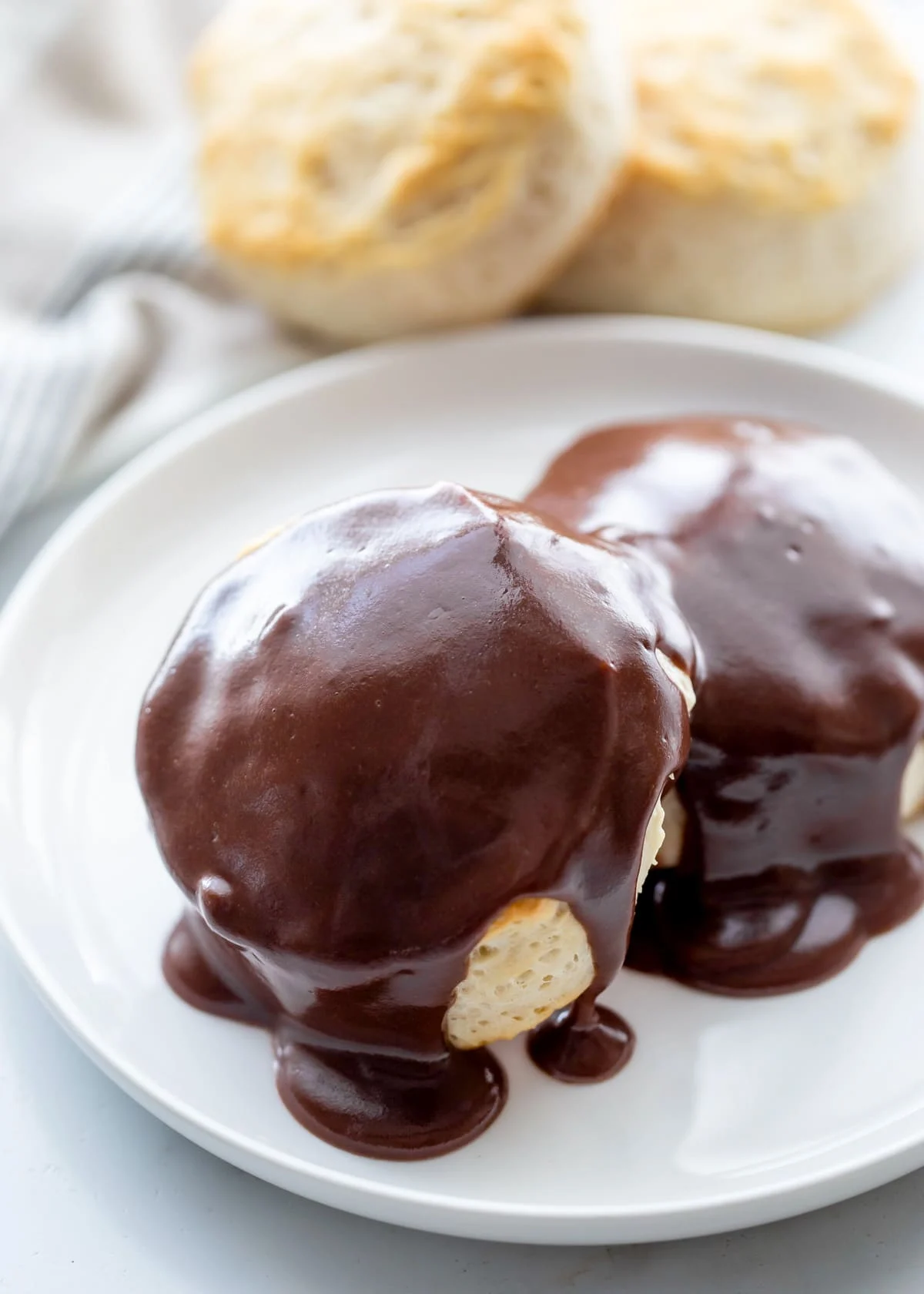
Imagine a rich, velvety sauce that combines the indulgence of dessert with the comfort of a Southern breakfast staple.
Chocolate gravy is a unique concoction that pairs perfectly with warm, flaky biscuits.
This sweet twist on traditional gravies features a simple list of ingredients you’re likely to have in your pantry.
Ingredients:
- Cocoa powder: The base of your gravy’s chocolate flavor.
- Sugar: Adds sweetness to balance the cocoa.
- Milk: Gives the gravy its creamy consistency.
- Butter: Offers a silky, rich finish.
Preparing chocolate gravy is straightforward. Start by melting the butter in a skillet.
Blend the cocoa and sugar together, then whisk this mixture into the melted butter.
Gradually pour in the milk and stir constantly until the gravy thickens to your desired consistency.
If you’re ready to transform your breakfast experience, chocolate gravy is a must-try. Serve it hot over fresh biscuits for a truly decadent treat.
If you’ve got a sweet tooth, this Southern delicacy also pairs wonderfully over pound cake or even ice cream for a dessert twist.
Some might say chocolate gravy is the epitome of comfort food. Make it once, and you’ll understand why it’s a cherished treat in many Southern kitchens.
Enjoy every spoonful of this chocolatey goodness, and don’t hesitate to indulge; after all, breakfast is the most important meal of the day!
10. Mushroom Gravy
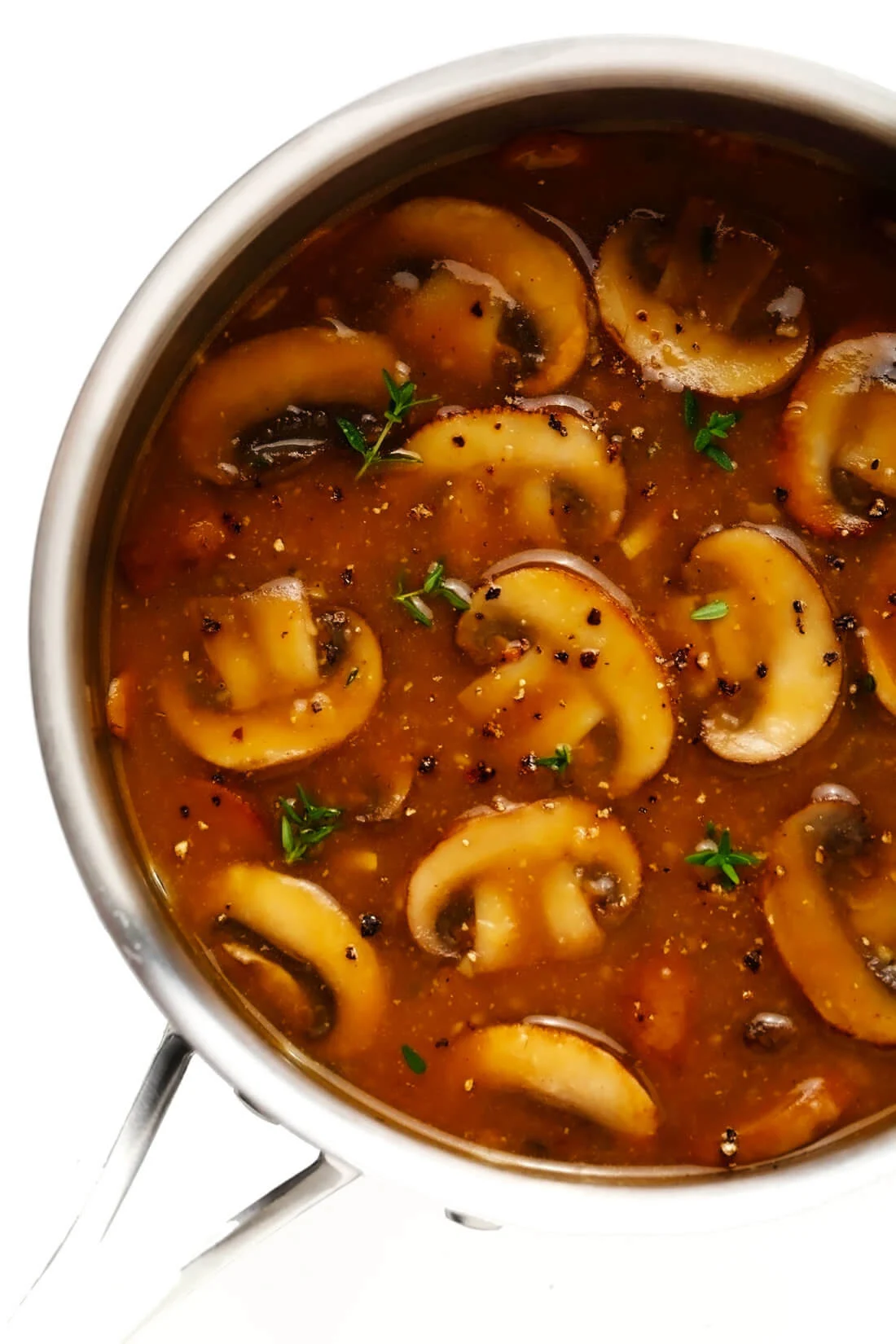
Mushroom gravy is a rich and flavorful sauce that pairs beautifully with a variety of dishes.
You’ll love how it enhances the taste of mashed potatoes, meats, and other sides.
Start by selecting your favorite mushrooms; they’re the star of this gravy.
You might use button mushrooms for their mild flavor or portobello mushrooms for a deeper taste. Clean the mushrooms carefully and slice them thinly.
Here’s a simple guide for making your mushroom gravy:
- Sauté mushrooms: In a large skillet, melt some butter over medium heat. Add the mushrooms and cook until they’re golden and their moisture has evaporated.
- Make a roux: Sprinkle flour over the mushrooms, stirring to coat them evenly. The flour will thicken your gravy.
- Add liquid: Slowly pour in your choice of stock—chicken, beef, or vegetable—while stirring constantly to avoid lumps. Simmer until the gravy reaches the desired consistency.
Remember to keep the heat on a medium setting to prevent the bottom from burning.
Stir the gravy frequently for a smooth, velvety texture that will make your taste buds dance.
Whether you’re spooning it over a mound of fluffy mashed potatoes or using it to add moisture to a succulent roast, mushroom gravy is an absolute delight that can elevate the simplest dish to something special.
Enjoy the heartwarming flavors and the irresistible aroma that fills your kitchen as you prepare it.
11. Shrimp Gravy
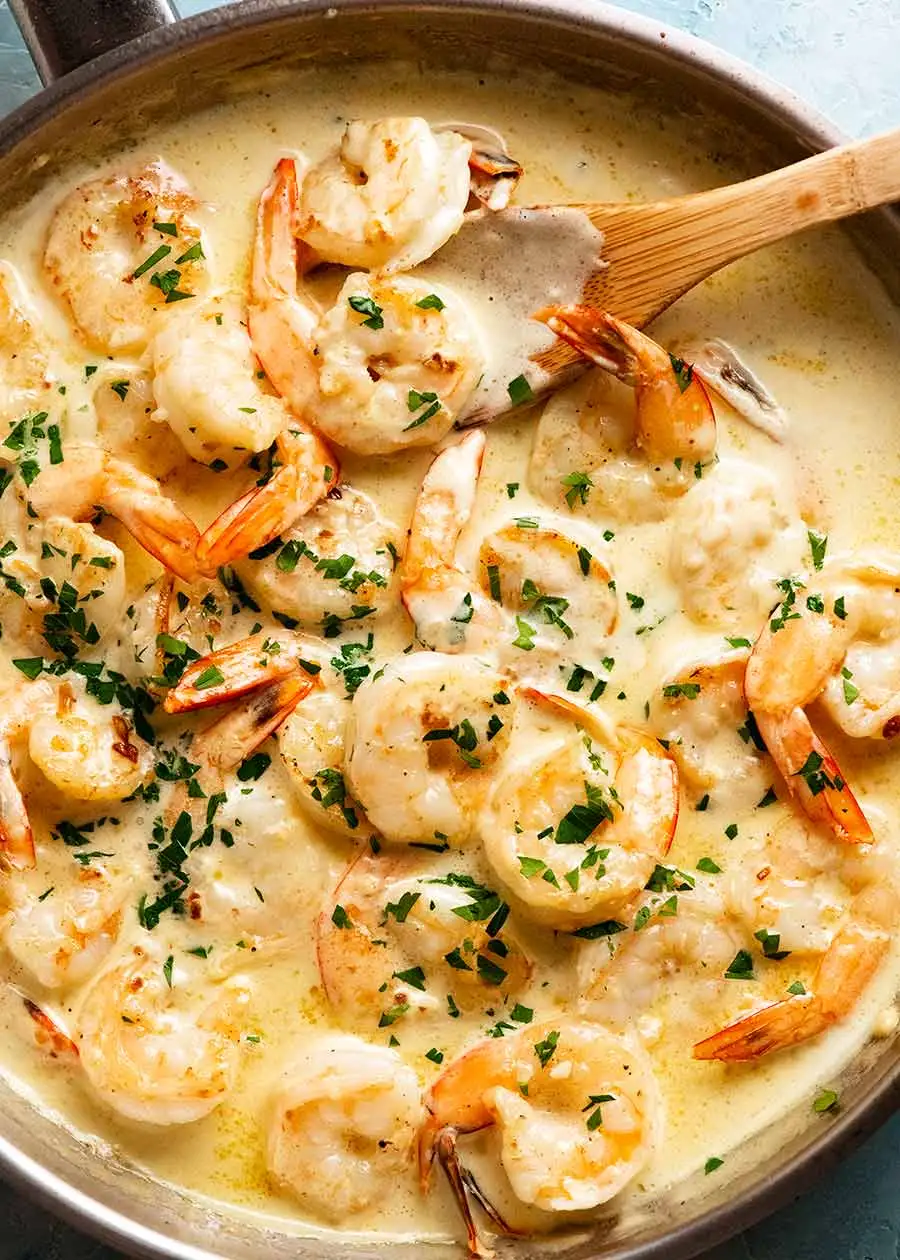
Shrimp gravy is a delightful sauce that you can easily incorporate into your Southern-inspired meals.
Essentially, shrimp gravy consists of succulent shrimp simmered in a roux-based sauce that’s infused with the rich flavors of stock and butter.
Ingredients:
- Shrimp: Peeled and deveined, shrimp serve as the star of this gravy.
- Flour: A thickening agent for the roux, which provides the base for the gravy.
- Butter: Lends a rich, smooth texture and a hint of creamy flavor.
- Milk: Sometimes used to add creaminess to the gravy.
- Pepper: Provides a simple, slightly spicy seasoning.
- Stock: Shrimp or chicken stock can be used for extra flavor depth.
To make shrimp gravy, begin by cooking your shrimp with a touch of pepper until they become pink and slightly golden.
Remove them from the pan and melt some butter in the same pan to start your roux with flour.
As the roux turns a lovely golden color, slowly whisk in your stock, ensuring a smooth texture.
| Step | Action |
|---|---|
| 1. Cook | Sauté shrimp with pepper. Set aside. |
| 2. Melt | Melt butter in a pan. |
| 3. Whisk | Add flour to make roux, then whisk in stock. |
Pour this thickened mixture over cooked rice to enjoy a comforting dish that’s both savory and rich.
You may find different variations of shrimp gravy, including those with tomatoes or a Cajun twist, adding even more layers of flavor to this Southern favorite.
Each bite promises the down-home comfort of classic Southern dining with the delightful seafood twist that shrimp adds to the table.
12. Onion Gravy
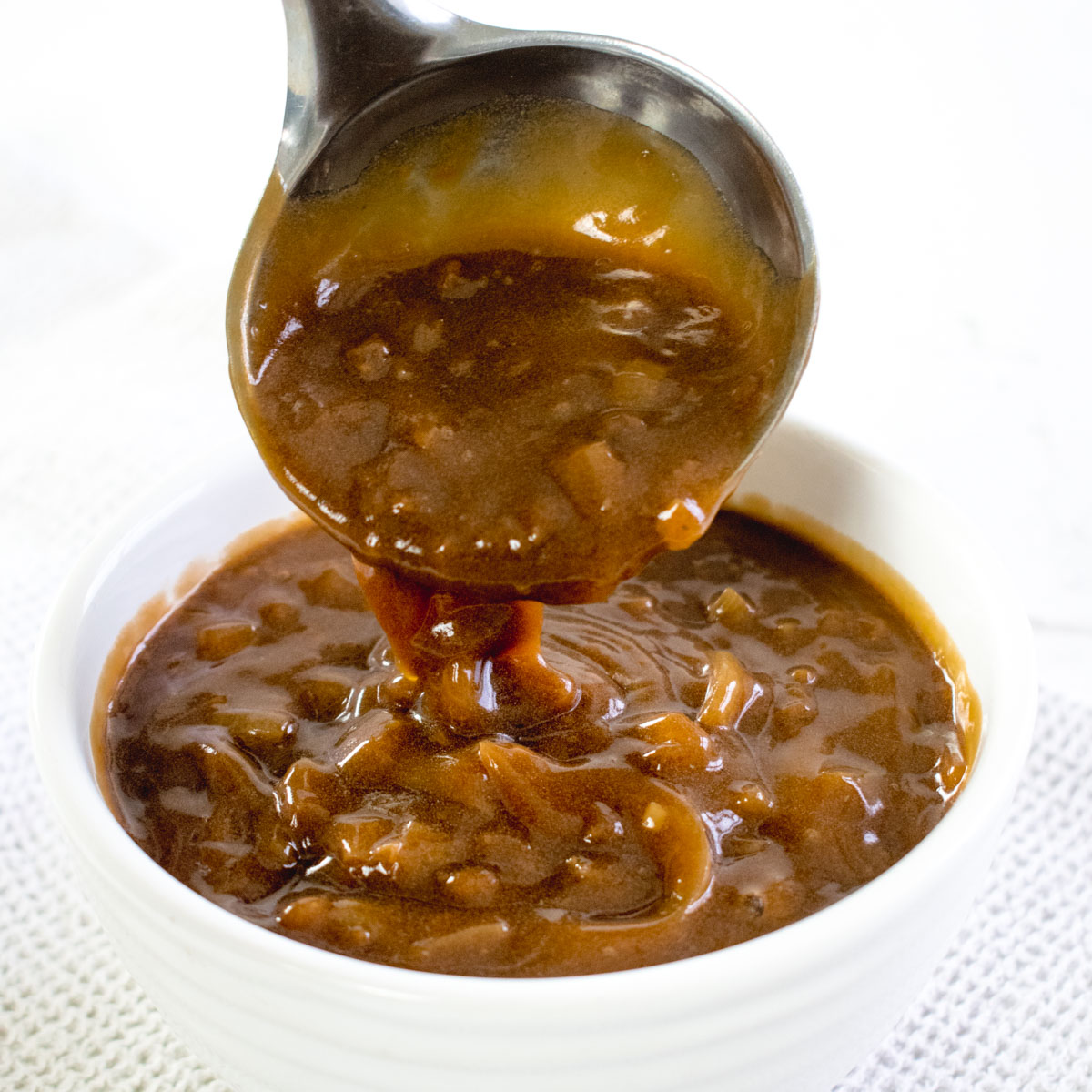
When you crave something hearty to complement your roasted meat, onion gravy offers a rich, savory addition that’s both comforting and flavorful.
To start, you’ll need some butter to sauté the onions until they caramelize, unlocking a deep, sweet taste profile.
This process typically takes about 30 minutes, but the mouthwatering aroma and resulting flavor are worth the patience.
| Ingredients | Quantity |
|---|---|
| Butter | 2-4 tablespoons |
| Onions | 2 large, sliced |
| Beef stock | 2 cups |
| Red wine | 1/2 cup |
| Thyme | 1 teaspoon |
Once the onions have reached a beautiful golden hue, you’ll find that adding a splash of red wine not only deglazes the pan but also provides a complex layer of flavor.
Allow the wine to reduce slightly before introducing the beef stock, which forms the base of your gravy.
Bring your mixture to a boil, and then let it simmer. As it simmers, it’ll start to thicken into that luscious, velvety sauce known as onion gravy.
A dash of thyme will lend an earthy note that complements the richness of the onions and beef stock.
For an even thicker consistency, some recipes suggest incorporating a roux made from flour cooked in butter or a whisk of cornstarch and water.
Simmering the gravy further blends all the flavors together, and soon, you’ll have the perfect addition to pour over your slice of roasted meat or a warm bed of mashed potatoes.
13. Yellow Gravy
Yellow gravy adds a warm, golden hue to your dishes due to the use of turmeric, a spice known not only for its vibrant color but also for its health benefits.
When you prepare yellow gravy, you might start with butter as the base, melting it down before adding flour to create a roux. This mixture acts as a thickening agent.
To achieve the creamy texture you love, slowly incorporate cream into the mix, stirring continuously to avoid lumps.
The velvety consistency of the gravy makes it an excellent companion to various meats like chicken or pork, enveloping them in a rich, luscious sauce.
A selection of spices can further define the character of your gravy.
Besides turmeric, you might reach for onion powder, garlic powder, and a pinch of salt and pepper.
These seasonings contribute depth and elevate the taste, creating a gravy that’s both comforting and indulgent.
Remember that balance is key. Turmeric brings in a slight bitterness if overused, so adjust according to your palate.
A successful yellow gravy is one that complements your meal, infusing it with a mild yet present warmth, both in color and flavor.
Here’s a quick breakdown of what you’ll need:
- Butter: For starting your roux.
- Flour: To thicken the gravy.
- Cream: For creamy consistency.
- Turmeric: For the signature yellow color.
- Spices: To enhance the flavor.
- Meats: Ideal for pairing with the gravy.
14. Turkey Gravy
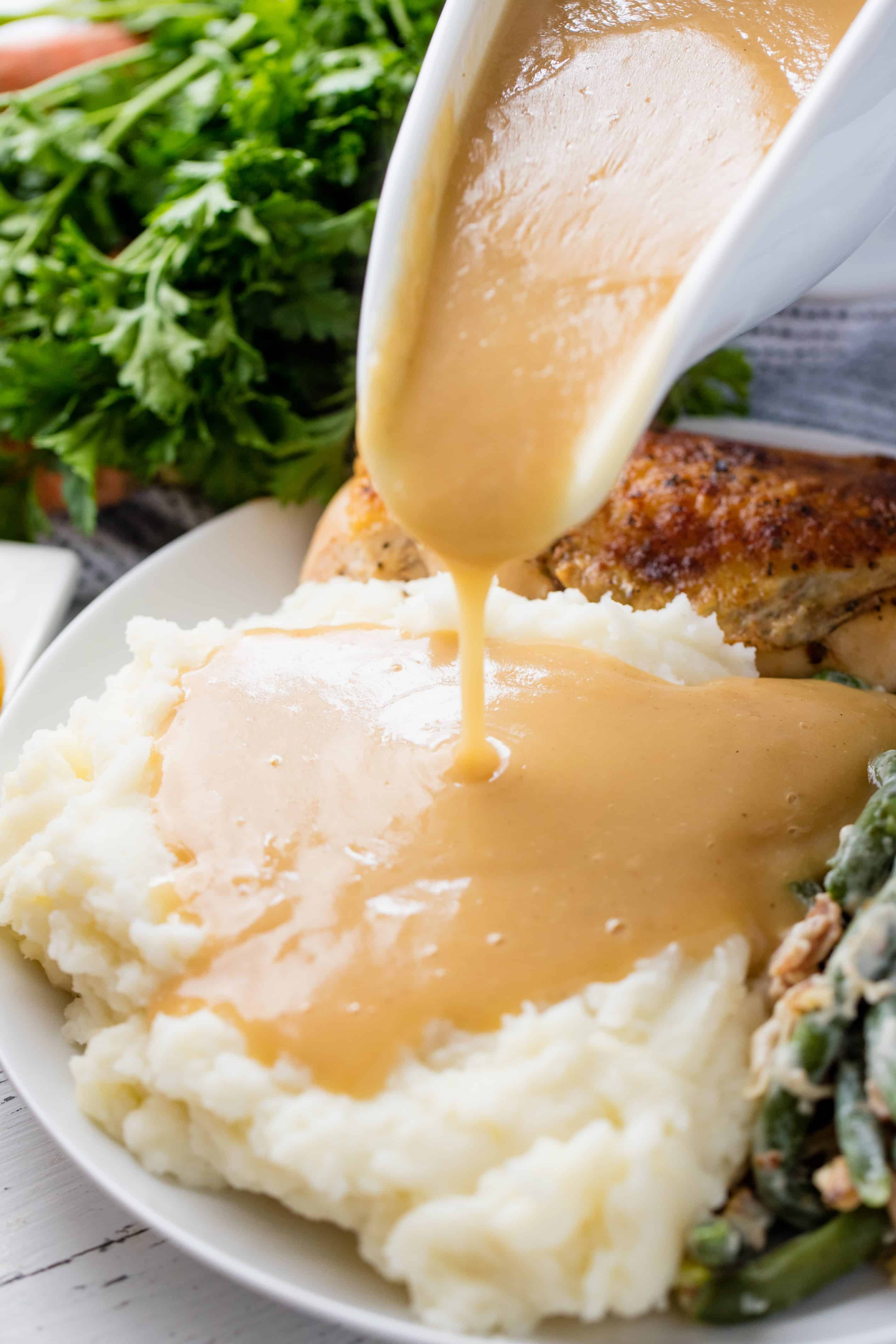
When it comes to making turkey gravy, you’ll find it’s a classic addition to your Thanksgiving feast. Juicy turkey isn’t complete without a smooth, rich gravy to drizzle over it.
Start with the drippings from your roasted turkey, which are the flavorful juices and fat that collect in the bottom of the roasting pan.
These drippings serve as a base, adding depth and the essential turkey flavor to your gravy.
You’ll need to separate the fat from the juices—use the fat to create a roux, which is a mixture of fat and flour, and it’s the magical thickening agent for your gravy.
Here’s a simple guide to making turkey gravy:
- Skim the fat from the pan drippings and place about 4 tablespoons of it in a saucepan.
- Sprinkle in an equal amount of flour.
- Cook the roux on medium heat, stirring constantly, until it turns a light brown color.
- Gradually pour in turkey broth, whisking continuously to prevent lumps.
- Allow the mixture to simmer until it thickens, usually 5–10 minutes.
- Season with salt and pepper to taste.
Remember, patience is key! Keep whisking to achieve a creamy consistency.
If you’ve run out of broth, you can also use chicken or vegetable stock.
For those times you need a helping hand, check out tips from the Ultimate Guide to Turkey Gravy for more detailed instructions.
Enjoy your holiday meal with this timeless turkey topper!
15. Brown Gravy
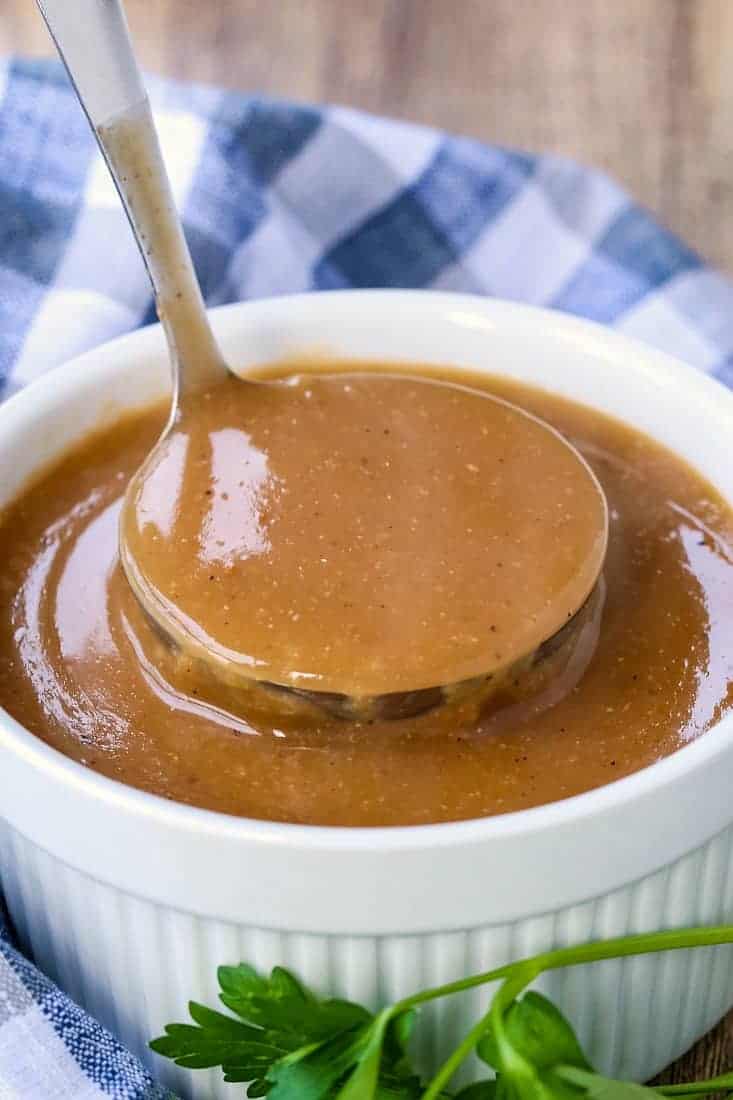
When you’re looking for a classic gravy to pair with your roasted meat or mashed potatoes, brown gravy is a go-to choice.
This savory sauce adds richness and deep flavor to many dishes.
Ingredients
- Beef Stock: Forms the base of the gravy, providing a robust flavor.
- Butter: Adds creaminess and helps in making the roux.
- Flour: Thickens the gravy, creating a desirable consistency.
- Onion: Often included for additional savoriness.
Preparation
To make brown gravy, you start by cooking butter and flour together to form a roux.
Once you achieve a light brown color, slowly add in your beef stock while constantly whisking to prevent lumps.
Let the mixture simmer, which will allow it to thicken to the perfect gravy consistency.
If you want an extra kick of flavor, consider sautéing some onion before you add in the flour and butter.
Keep in mind that the key to a rich and flavorful brown gravy is a good-quality beef stock.
Also, ensure you cook the roux long enough to get rid of the raw flour taste, but be careful not to burn it.
Feel free to season your gravy with salt, pepper, or any herbs you enjoy.
Brown gravy pairs exceptionally well with mashed potatoes and makes for an irresistible topping for all kinds of roasted meats.
Enjoy the heartiness it brings to your meal!
16. Sawmill Gravy
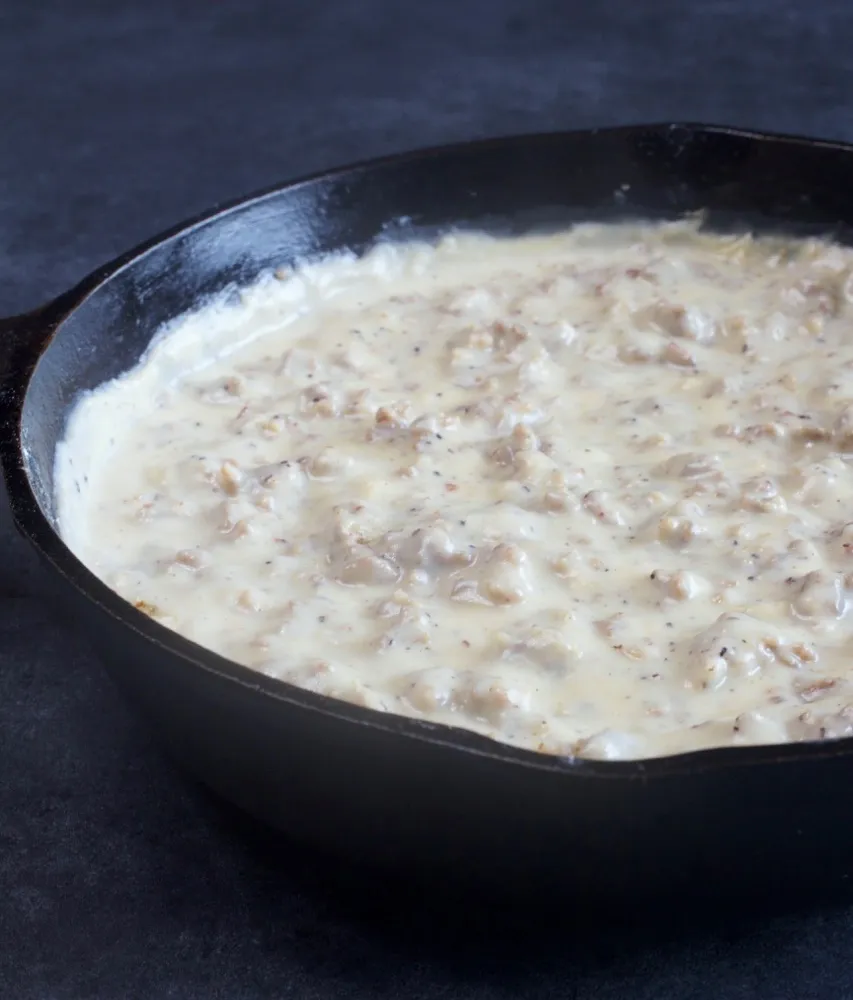
Sawmill gravy, a staple of Southern breakfasts, starts with sausage drippings as its flavorful base.
Begin by cooking your favorite sausage in a pan, letting the drippings form a layer of fat; these drippings add a savory depth to the gravy.
Here’s a simple recipe to make your own sawmill gravy:
- Ingredients:
- Sausage drippings
- 1/4 cup all-purpose flour
- 2 cups milk
- Salt and freshly ground pepper to taste
- Instructions:
- Once you’ve browned and removed the sausage, use the same pan with the drippings.
- Sprinkle the flour over the drippings; whisk it until smooth to create a roux.
- Slowly pour in the milk while continuously stirring to combine with the roux.
- Keep stirring and cook until the gravy starts to thicken. This may take a few minutes.
- Season with salt and pepper.
Serve your sawmill gravy generously over warm, flaky biscuits or hearty grits.
This rich, creamy gravy is not just for breakfast; you can enjoy it at any meal for a comforting Southern touch.
Remember, the key to a perfect sawmill gravy is patience as it thickens and a good amount of stirring to ensure a smooth texture.
Enjoy the robust flavors you’ve created right from your skillet!
17. Hamburger Gravy
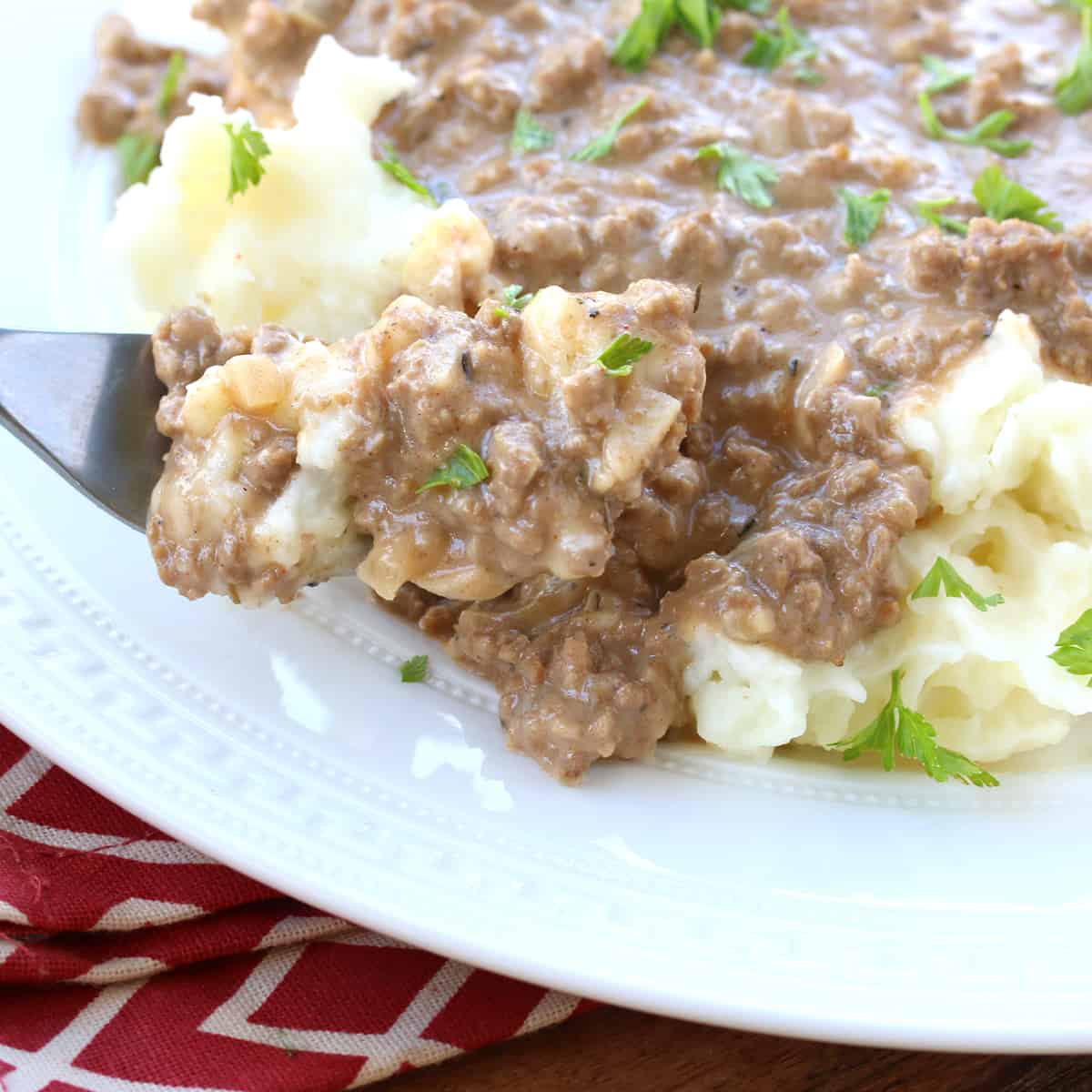
When you crave something hearty and comforting, hamburger gravy is a delightful choice. This gravy, which essentially involves ground beef in a thick and savory sauce, pairs exceptionally well with starches like mashed potatoes.
To start, cook your ground beef until it’s thoroughly browned—you’ll appreciate how this step builds a deep, rich flavor.
Once done, onions often join the beef in the pan, softening and adding a subtle sweetness to the mix.
Now, for the magic to happen, sprinkle some flour over the cooked meat and onions. This acts as a thickener, setting the stage for a creamy texture. Gently stir until everything’s nicely coated.
Next, you’ll pour in milk, which transforms into your rich gravy base upon heating and stirring.
Watch as it thickens into that silky, luscious sauce!
Season with pepper to taste; it gives your gravy a slight kick and a hint of warmth.
Remember to taste and adjust the seasoning to your liking, as this will personalize the dish to your palate.
Recipe steps:
- Brown ground beef.
- Add onions.
- Sprinkle with flour.
- Pour in milk and stir continuously.
- Season with pepper.
When everything comes together, ladle the hamburger gravy over a bed of fluffy mashed potatoes for a meal that feels like a hug on a plate.
This simple, down-to-earth dish is a staple that you can turn to any day of the week for a satisfying meal.
18. Giblet Gravy
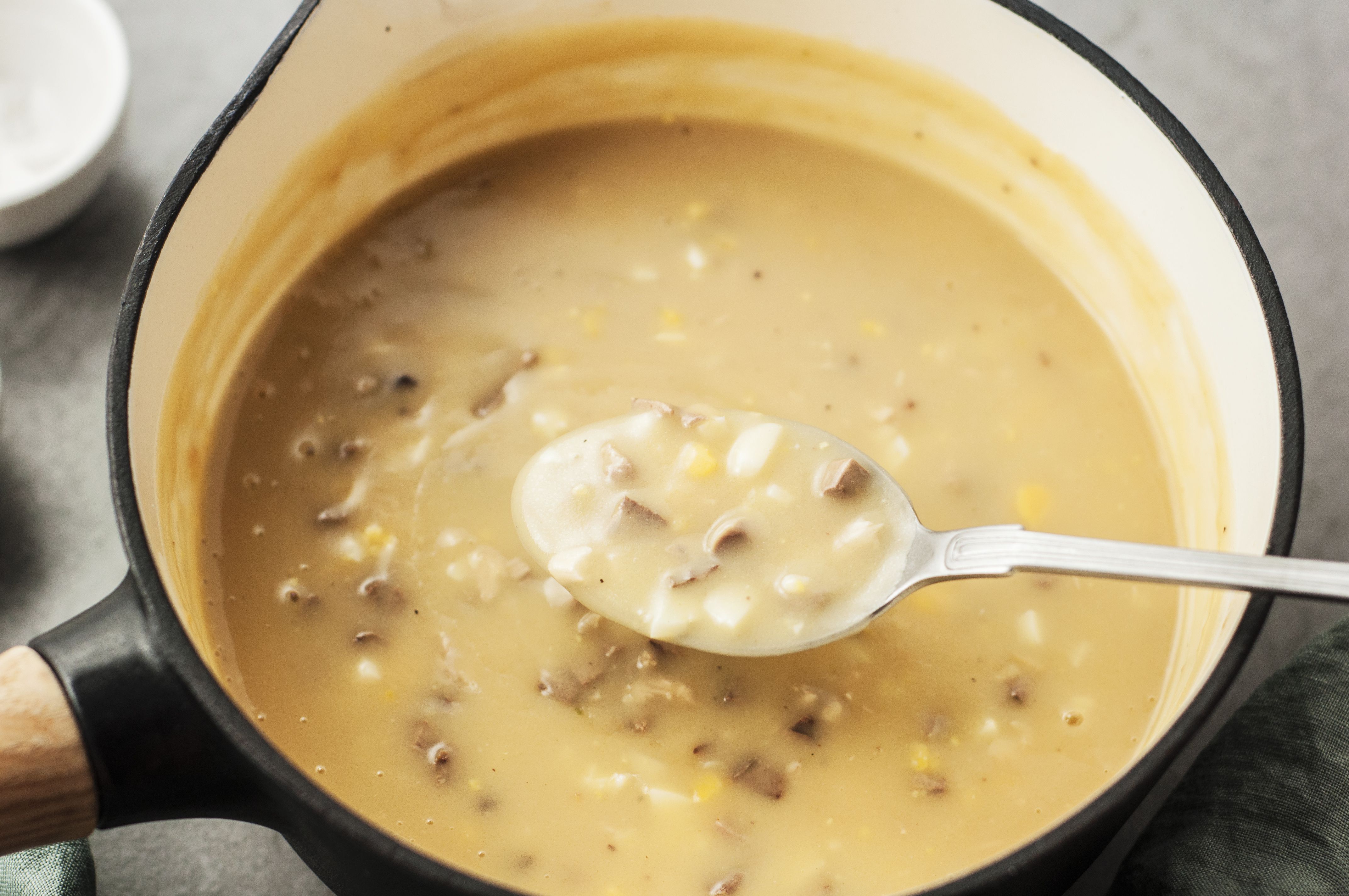
Giblet gravy is a savory sauce that you can make with the giblets of a turkey. These giblets, which include the heart, gizzard, and liver, contribute a rich flavor to the gravy.
To begin, you’ll simmer these parts in stock to create a flavorful broth.
Ingredients:
- Turkey giblets
- Butter
- Flour
- Stock (chicken or turkey)
- Salt and pepper
Instructions:
- Start by simmering your turkey giblets in stock until they are tender. This process extracts flavors, creating a base for your gravy.
- Next, strain the giblets from the broth and finely chop them. Keep the broth; you’ll use it in the following steps.
- In a separate pan, melt butter over medium heat. Then, whisk in flour to create a roux. This mixture will thicken your gravy and give it a smooth texture.
- Gradually pour the giblet broth into the roux while continuously whisking to prevent lumps. You’ll notice the mixture thickening.
- Once the desired consistency is achieved, add the chopped giblets back into the gravy.
- Season with salt and pepper to taste.
Enjoy your homemade giblet gravy over mashed potatoes, stuffing, or the turkey itself. This classic dish brings a depth of flavor that complements a wide array of traditional sides, making it a holiday favorite.
Remember to cook your gravy to the right thickness, as it should pour easily, yet coat a spoon with its velvety texture.
19. Chili Gravy
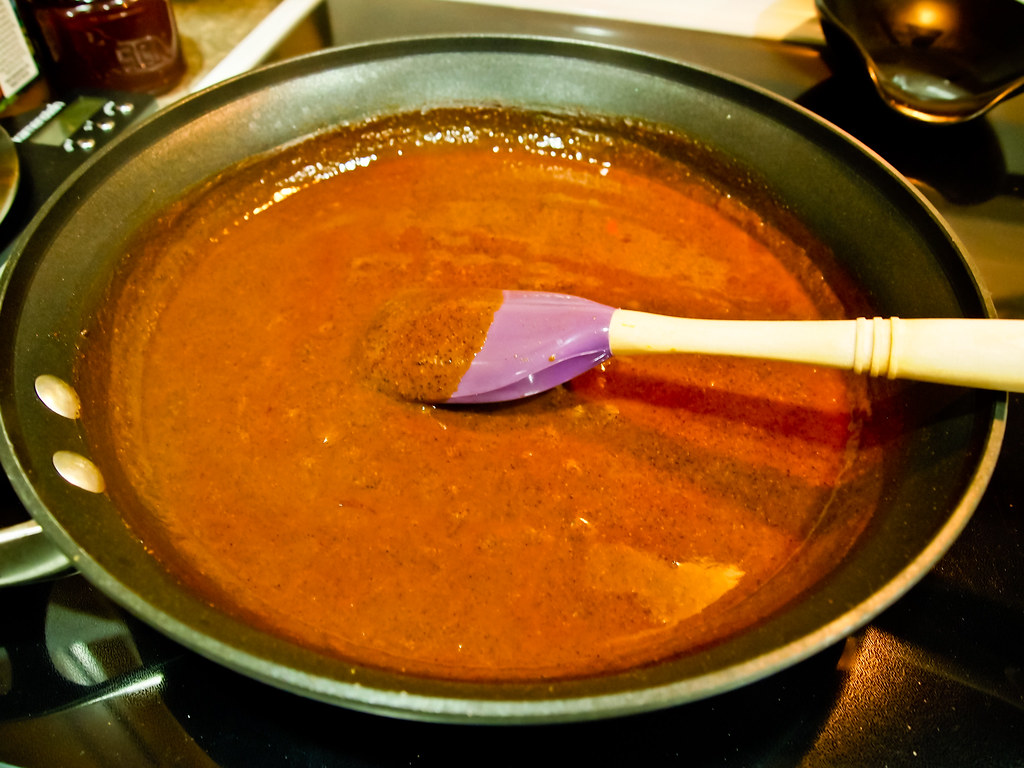
Chili gravy is a savory, Tex-Mex style sauce that adds a hearty kick to your favorite dishes. It traditionally combines chili powder and cumin, providing a distinct flavor profile you’ll recognize from classic Tex-Mex cuisine.
To prepare chili gravy, you start with a base of fat, typically lard or vegetable oil, mixing it with flour to create a roux that will thicken the gravy.
Ingredients:
- Fat (lard or oil)
- Flour
- Chili powder
- Cumin
- Beef broth
- Optional: garlic powder, paprika, Mexican oregano
The preparation process is simple and begins with heating the fat, then whisking in the flour to ensure there are no lumps.
You gradually add in the beef broth, stirring continuously to keep the gravy smooth.
Preparation Steps:
- Heat your fat in a pan.
- Add flour to create a roux.
- Whisk in chili powder and cumin.
- Pour in beef broth gradually.
- Stir until thickened to the desired consistency.
Feel free to adjust the amount of chili powder and cumin per your taste preferences.
The result is a velvety sauce that’s ideal for enchiladas, tacos or as a topping for meats.
Remember to cook your gravy over medium heat to avoid burning, and stir constantly for a perfect texture.
For an authentic chili gravy recipe with detailed proportions and additional tips, you could explore Miss Buttercup’s Complete List of Gravy Types or for a step-by-step guide, Kevin Is Cooking offers a Tex Mex Chili Gravy recipe that might be just what you need to enhance your meals.
20. Lauki Kofta Curry Gravy
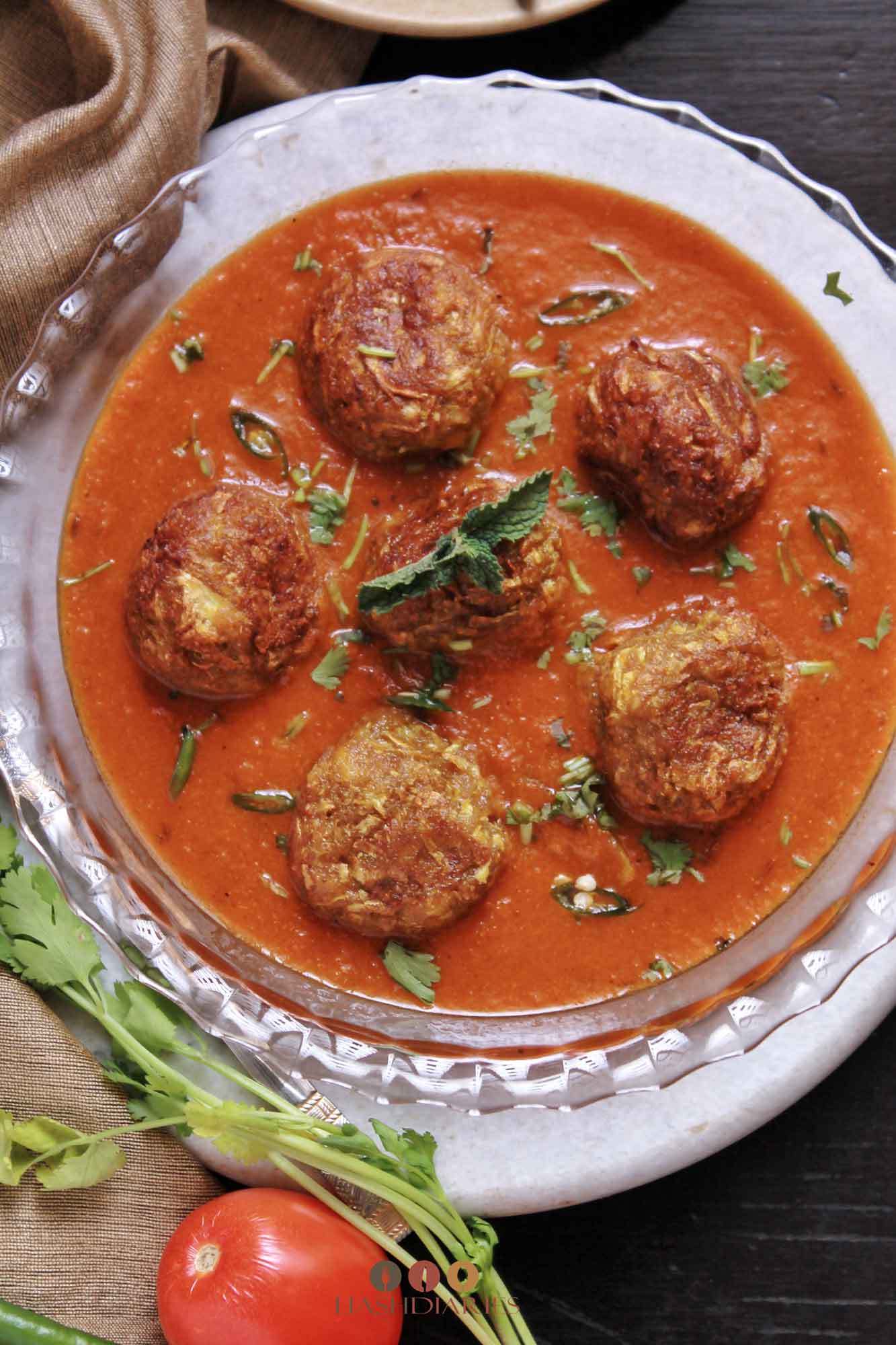
Preparing the gravy for Lauki Kofta Curry involves cooking down tomatoes to create a rich base. Begin by pureing ripe tomatoes to achieve the smooth texture that characterizes this gravy.
Your bottle of gourd koftas will eventually simmer in this tomato base, so ensure it’s well-seasoned.
In Indian cuisine, spices form the heart of any dish, and the lauki kofta gravy is no exception.
An array of spices, such as turmeric powder, red chili powder, coriander powder, and garam masala, give the gravy its distinctive warm flavor.
Saute these spices in oil until they release their aroma, which is usually a sign that they are ready.
To add creaminess to the gravy, incorporate cream or yogurt whilst keeping the heat low to prevent it from curdling.
This not only adds richness but also beautifully balances the tang of the tomatoes.
Here’s a quick rundown of the steps to make the gravy:
- Tomato Puree: Blend the tomatoes until smooth and cook with oil in a pan.
- Spice Mix: Carefully add turmeric, red chili, coriander, and garam masala powder.
- Cream Addition: Stir in the cream or yogurt for a velvety texture.
- Simmer: Allow the gravy to simmer gently so the flavors meld together.
Remember, you want the gravy to be flavorful enough to complement the mild taste of the bottle gourd koftas that will soak up this delicious sauce.
Carefully adjust salt before adding the koftas, and serve hot with rice or flatbreads.
21. Salt Pork and Milk Gravy
You can create a comforting and rich Salt Pork and Milk Gravy that’s perfect for drizzling over biscuits or pork chops.
This classic gravy starts with salt pork. You render it until it’s crispy and golden, releasing all its flavorful fat.
Here’s what you’ll need and how to make it:
- Dice up the salt pork: Aim for small pieces to ensure even cooking and flavor distribution.
- Render the salt pork: Place it in a pan over medium heat, cooking until the pieces are crispy and the fat is rendered. Ingredient Quantity Salt pork 1/2 cup, diced All-purpose flour ¼ cup Milk 2 cups Black pepper to taste.
- Create a roux: Sprinkle flour over the crispy bits and rendered fat and stir to combine. This forms the thickening base for your gravy.
- Whisk in milk: Gradually pour in milk while whisking vigorously to prevent lumps. Keep stirring until the mixture thickens to a creamy consistency.
- Season: Add black pepper to taste and additional salt if needed (although salt pork often provides enough saltiness).
If you don’t have enough fat from the salt pork, you can use lard instead for an even heartier gravy. Remember to keep stirring over low heat to get that smooth, thick texture that coats the back of a spoon. Enjoy your homemade gravy with warm biscuits or atop sizzling pork chops for a traditional Southern meal.




